Jose Joya was the extroverted abstractionist whose works during the decade of the 1960s and 1970s were inspired by the American abstract expressionist movement. He later distinguished himself by creating an authentic Filipino abstract idiom that transcended foreign influences. Most of Joya’s paintings of harmonious colors were inspired by Philippine landscapes, such as green rice paddies and golden fields of harvest.
He espoused the value of kinetic energy and spontaneity in painting which became significant artistic values in Philippine art. His paintings clearly show his mastery of ‘gestural paintings’ where paint is applied intuitively and spontaneously, in broad brushstrokes, using brushes or a spatula or directly squeezed from the tube and splashed across the canvas.
Joya was one of the most prolific Filipino painters, producing a lifetime body of works that included elegant landscapes of the spirit characterized by broad strokes or wild impasto techniques with a variety of surface textures; through his rice paper collages where he applied bits and pieces of handmade papers, creating moving forms within space; and through multimedia forms such as painting on tiles and plates; as well as graphic arts.
The strength of Joya’s abstract painting rested on strong foundation of drawing or the mastery of draftsmanship. His series of realistic studies and drawings of the nude female and male forms and landscape studies such as perspective principles, tonal gradations and a range of drawing techniques. Joya has worked in a variety of drawing media such as graphite, charcoal, pastel, and pen markers.
This collection of 12 paintings on exhibit are “travelogue” studies during Joya’s trips to China, Japan, and Singapore from 1960 to the 1980s. Rendered in felt marker ink on paper, they are sweeping images of landscapes, palaces, and temple shrines. The artist, in quick broad strokes, sought to capture the spirit and image of the moment and place, freezing it forever in time to give viewers the experience of looking through the artist’s eye.
